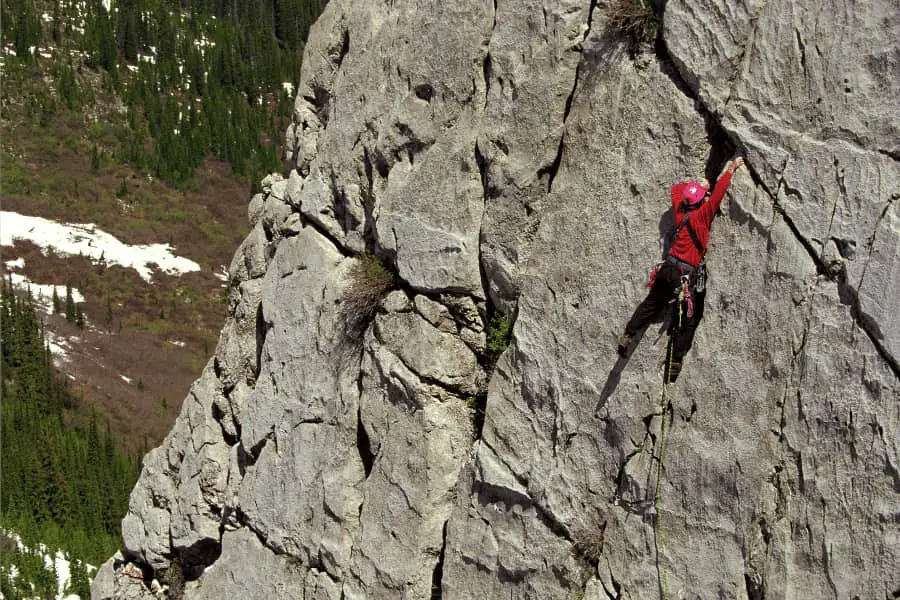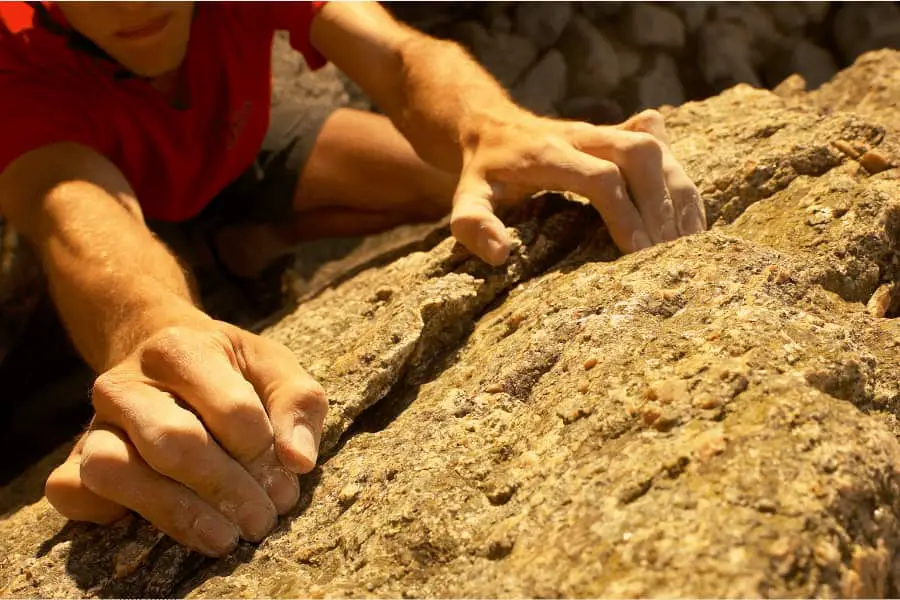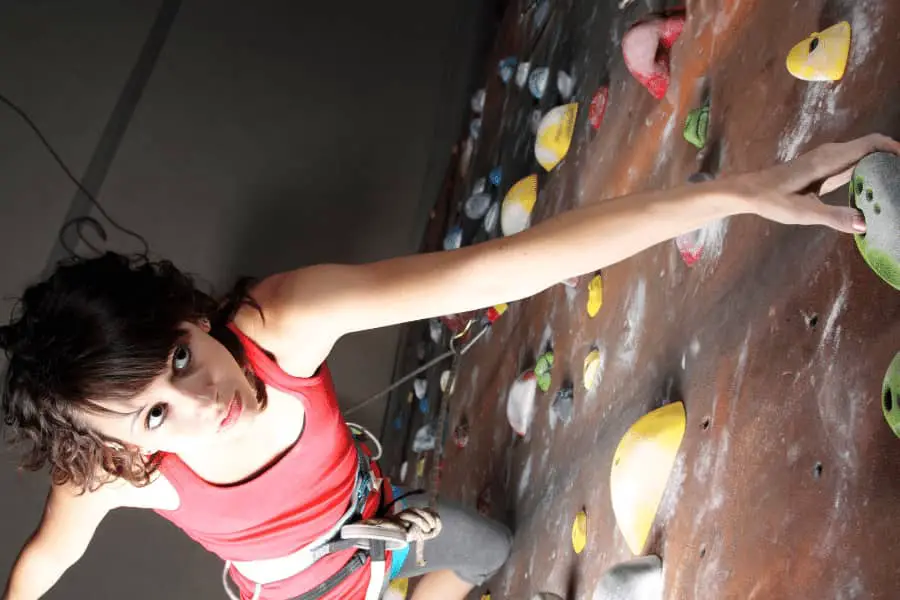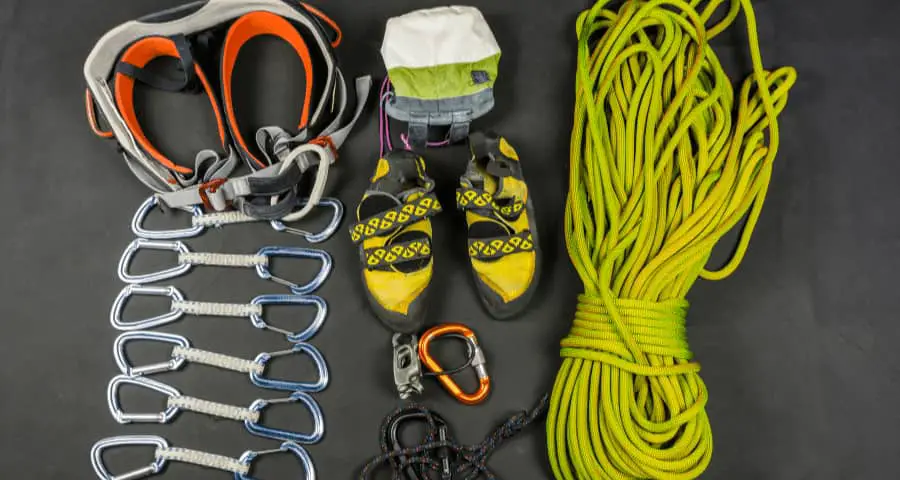
Although I have never taken a climbing trip myself, a few of my climbing partners have. Because I am a very curious individual, I picked their brains on how they prepare for such a thing. In addition to this, I spent many hours researching how other climbers prepare for their trips as well. Here is what I found out:
The best way to prepare for a rock climbing trip is to get yourself ready physically and mentally. You will want to make sure that you are in peak physical condition and your skin is ready for the climbing trip. On top of this, you will want to be in a good head space and have clearly defined goals.
Preparing yourself physically and mentally can be very complicated to do correctly. In the sections below I lay out all of the major things you need to consider when doing so.
If you are interested in seeing what the current prices are for the most popular rock climbing training aids, you can find them on Amazon by clicking here. Using the Amazon affiliate link above and/or other links in the article helps support this website.
How To Physically Prepare For A Climbing Trip
Going on a climbing trip can be very exciting and nerve wrecking at the same time. Preparing yourself physically to perform your best is essential to having a great experience. You will not have a great time on your climbing trip if you feel heavy and your fingers are rubbed raw.
Prepare Your Skin For The Climbing Trip
Preparing your skin for the trip is one of the most, if not the most, important physical preparations you can make.
You should start climbing outside 2 to 3 months before your trip if you are mainly climbing on plastic right now. This will help prepare your skin for the rock and will build up the necessary callouses. If you do not have 2-3 months before your trip, I recommend bringing athletic tape or liquid skin with you to help protect your fingers against the rock.
If you have already been climbing outside and have a decent amount of callouses built up then you are in a good spot. Just make sure that you continue to climb outside to be sure your hands don’t get soft.

You should start preserving your skin as much as possible 1 week before your climbing trip. To do this, cut back on your training routine (more to come on that later). In addition to limiting your climbing, you can start to wear gloves in the shower/pool/when washing dishes. This will help keep your hands hard and calloused.
Having baby hands when going on a climbing trip is a recipe for pain and disaster. Although you may be able to climb through the pain, it would be better if your didn’t have to on your trip. Treat skin care as an essential part of your climbing trip prep.
Increase Your Training Volume In Preparation For The Climbing Trip
On your climbing trip you will be climbing more frequently than you are right now. This will most likely be in an attempt to optimize the trip that you are taking. To prepare for this, you will need to ready your body for the high volume of climbing to come.
I recommend increasing the amount of sessions and also the amount of time spent climbing in each session. This will help you up your mileage and increase your muscular and cardiovascular endurance.
Your climbing trip won’t be any fun if you get winded after 2 hours of climbing and need a full 2 days to recover. Preparing yourself to handle the sheer amount of volume you are planning to climb is essential to make sure you are fully prepared for your trip. If you aren’t in good enough shape to do a climbing trip you might as well take a vacation and climb during your down time.
In addition to increasing your condition, increasing the frequency of your climbing will help you get in tune with your body. Adding more mileage no matter how experienced of a climber you are will help you build a better mind-muscle connection and can help you improve your technique. Being on top of your game is essential when taking a climbing trip.
Eat Healthier And More Nutritious Meals Leading Up To The Climbing Trip
To perform at your peak physical ability you will want to start fueling your body the proper foods. The best analogy for this is treating your body like a sports car. You wouldn’t put crap gasoline in a Lamborghini just like you wouldn’t put junk food in your body.
I recommend loading up on unprocessed foods and maximizing your fruit and vegetable intake. Eating whole foods and complex carbohydrates will help you prepare your body to perform at its absolute best. It is ideal to get a good mix of protein, carbohydrates, and healthy fats.
Some of the best foods you can eat to prepare your body for you climbing trip are:
- Fruits
- Vegetables
- Brown Rice
- Whole Grain Pasta
- Potatoes
- Beans
- Chicken
- Salmon
- White Fish
- Tuna
- Turkey
Fueling your body with the proper nutrients will allow you to perform at your peak. I recommend that you start eating healthy, nutritious foods at least 2 weeks before your climbing trip for optimal performance. Try to limit candy, junk food, and sweets.
Adjust Your Training Routine Right Before You Leave For The Climbing Trip
Now that you have increased your endurance, you will want to cut back right before your trip. Cutting back approximately 5 to 7 days before your trip will allow the maximum time for your body to fully recover and be in peak condition.
Do NOT completely stop climbing during this time. If you take an entire week off before your trip you can feel cold and unpracticed when climbing. The entire idea of this week is to make sure you are well rested and ready for your climbing trip.

Instead of taking the entire week off, you should climb about 2 to 3 times during this time. Make sure the climbing sessions are less than an hour. During these sessions you should practice on your technique and make sure you are feeling strong.
Do not try to improve your strength within this last week. This is like trying to learn everything 20 minutes before the test. Your strength is what it is at this point. All you can do is improve your mental mindset and properly recover before your trip.
How To Mentally Prepare For A Climbing Trip
Mental preparation for your climbing trip is probably even more important than the physical preparation. It doesn’t matter how good you feel physically if you are not mentally ready for your trip.
Communicate With Your Climbing Companions About What They Want To Do On The Climbing Trip
Communication is key in all good relationships. This holds true for your climbing partner relationships as well.
The best way to adequately prepare for your climbing trip is to ask your climbing companion(s) what they hope to get out of the trip. There is no point in preparing yourself mentally and physically for months if all of your climbing companions only want to take a leisurely approach to climbing and do more sight seeing than climbing.
This should be discussed ahead of time so everyone is on the same page as to what to expect. Ideally you will all want to accomplish the same thing on your climbing trip. Keep in mind, if your climbing companions have different goals than you, compromising will keep everyone happy.
Don’t completely ditch your desires but also don’t be a dictator and force your climbing companions to do only what you want. Compromising is key and will make the trip the most enjoyable for everyone involved.
Research The Expected Weather Conditions For Your Climbing Trip
Unfortunately, your climbing trip will be extremely weather dependent. I highly recommend researching the expected weather conditions for the area that you will be going. Try to pick the dates that will have the best weather.
If you are looking at booking a climbing trip months out in advance, I suggest looking up the monthly weather statistics of the area. Try to pick the month that has the least average precipitation and the best average temperature you can find. You may have to sacrifice nice temperatures for little precipitation in some areas.
Don’t give up all hope if you get stuck in a rain storm during your climbing trip. Climbing in the rain is possible and makes for an incredible experience. To learn more about the pros and cons of climbing in the rain you can check out my article linked here.
Plan The Logistics Of Your Climbing Trip
For most climbers this is the boring part. Even though this part may be boring, it is the most necessary part. You will need to plan out the following logistics:
- Transportation to and from the airport. (if necessary)
- Your plane tickets (if necessary)
- Transportation to and from the climbing areas
- Where you will be staying
- Nearby places to eat and grocery shop
The list above provides great reasons to just buy a van and live out of it. Climbing legends such as Alex Honnold have been known to live out of vans because it allows them to cross the country within a day and live incredibly cheap. Unfortunately for the average climber, this is not realistic and you will have to plan out the logistics of your climbing trip.
Make A List Of Everything You Need For Your Climbing Trip
Making a list of everything you need will be beneficial and will take a lot of the stress off of you when packing. Packing can be one of the most anxious and stressful things when preparing for a big trip. What if you forget something? What if one of your items is worn out and no longer good?

Making a list a week out and adding to it as the days goes by will help you remember everything you need to bring. As a last minute packer myself, I can say that I have forgotten very important things on more than one occasion. Be prepared and make the list. Check out my recommended gear page to see what I think are the best options for you!
Research Local Routes And Set Goals For Your Climbing Trip
Do not confuse this tip with setting an itinerary. Setting an itinerary can be very helpful for all of you extra-organized people but it is not necessary.
When going on a climbing trip you will want to take a look at what routes are there and decide which of these you would like to climb. You do not need to plan out every second of your day. Just lay out which routes you most want to climb.
My friends like to make top 5 or top 10 list depending on the duration of their trip. These 5 or 10 routes become the top priority to complete before they leave.
Researching the routes and laying out which ones you want to climb the most ahead of time will save you valuable time when you are there. Ideally, you will make the most of your time on your trip and not waste all of it sitting around looking for what you want to do.
Researching routes ahead of time will also allow you to set goals for your trip. Goals give you purpose and something to work towards when climbing. In addition to this, it gives you a chance to visualize yourself climbing the route. To learn more about how visualization can help your climbing, read the next section.
Practice Visualization Before Your Climbing Trip
Visualization can be a powerful tool when used correctly. Many great athletes and successful businessmen swear by visualizing every important event in their life. It will get you in the right headspace and will allow you to perform at your absolute best when the time comes.

Although I do not have much experience with actually planning a rock climbing trip, I have a tremendous amount of experience with visualization.
The best way I have found to practice visualization is to set aside 15 minutes every day and do as follows:
- Lay down in a dark room with the lights off and spread your arms and legs out wide.
- Breathe slowly and deeply.
- Feel yourself sinking deeper and deeper into the floor.
- Imagine yourself on the routes you wish to climb. Feel the rock on your fingers, feel your feet on the holds, smell the outside air, listen to the wind rushing around you.
- Imagine making moves on the rock. Imagine yourself moving, grabbing the next hold, changing your feet, feel your muscles tense up.
- Visualize making it to the top of the route. Imagine how you will feel: tired, pumped, elated, relieved.
Practicing this everyday will help your mind visualize success. When you get to the route, you will already have done it before. It will give your body the confidence it needs to perform at its best. Visualization is the most underrated techniques that climbers can employ.
Reach Out To Local Climbing Groups In The Area
This is quite possibly the most underrated tip in this post. By reaching out to local climbers and climbing groups via social platforms allows you to immerse yourself in the local climbing experience. Local climbers are more than willing to meet new climbers and show them their favorite routes. On top of this, they may show you places to climb that were better than those you were able to find on your own.
Local climbers will not only be able to introduce you to the best climbing spots but also their culture. Hanging out with them and getting to know their culture will make for an invaluable experience. Both of my climbing friends swear by doing this. They have said that hanging out and climbing with local climbers has been their favorite part of their climbing trips.
At the end of the day, you will want your climbing trip to be an enjoyable and memorable experience. Meeting local climbers will certainly be a worth while experience.
The bottom line? You will want to start preparing yourself physically and mentally about 1 to 2 weeks before your climbing trip. Research the local routes ahead of time and have a general idea of what you will want to climb. Tapering your training and eating nutritious food before the trip is essential to make sure you are able to perform at your peak.
